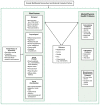Concepts and issues in COA research
- PMID: 15706767
- PMCID: PMC6826804
Concepts and issues in COA research
Abstract
Estimates of the number of children of alcoholics (COA's) and the prevalence of alcohol use disorders among them can vary widely from study to study depending on research design features such as sample selection, data collection strategies, and assessment methods. Although investigators agree that COA's are at higher risk for developing alcohol use disorders than children of nonalcoholics, problems with alcohol are not an inevitable consequence of COA status. Recent research has identified numerous biological, psychological, and social factors associated with a family history of alcoholism that may play a role in determining whether COA's will develop an alcohol use disorder. The conceptual model presented in this article gives a general overview of how such risk factors can interact with life stressors to influence alcohol-related behavior in COA's. (Subsequent articles in this issue explore some of the specific factors identified in the model in greater depth.).
Figures

Similar articles
-
Psychological characteristics of children of alcoholics.Alcohol Health Res World. 1997;21(3):247-54. Alcohol Health Res World. 1997. PMID: 15706777 Free PMC article. Review.
-
Breaking the cycle of addiction: prevention and intervention with children of alcoholics.Alcohol Health Res World. 1997;21(3):241-6. Alcohol Health Res World. 1997. PMID: 15706776 Free PMC article. Review.
-
A behavioral-genetic perspective on children of alcoholics.Alcohol Health Res World. 1997;21(3):210-7. Alcohol Health Res World. 1997. PMID: 15706771 Free PMC article. Review.
-
A critical analysis of COA research.Alcohol Health Res World. 1997;21(3):258-64. Alcohol Health Res World. 1997. PMID: 15706779 Free PMC article.
-
Neuropsychological responses in COA's.Alcohol Health Res World. 1997;21(3):232-6. Alcohol Health Res World. 1997. PMID: 15706774 Free PMC article. Review.
Cited by
-
Stress and the HPA axis: role of glucocorticoids in alcohol dependence.Alcohol Res. 2012;34(4):468-83. Alcohol Res. 2012. PMID: 23584113 Free PMC article. Review.
-
Is family history of alcohol dependence a risk factor for disturbed sleep in alcohol dependent subjects?Drug Alcohol Depend. 2018 Jul 1;188:311-317. doi: 10.1016/j.drugalcdep.2018.04.017. Epub 2018 May 19. Drug Alcohol Depend. 2018. PMID: 29843109 Free PMC article.
-
Gene-environment interplay in alcoholism and other substance abuse disorders: expressions of heritability and factors influencing vulnerability.Neurotox Res. 2004;6(5):343-61. doi: 10.1007/BF03033309. Neurotox Res. 2004. PMID: 15545018 Review.
-
Design of a Web-based individual coping and alcohol-intervention program (web-ICAIP) for children of parents with alcohol problems: study protocol for a randomized controlled trial.BMC Public Health. 2012 Jan 16;12:35. doi: 10.1186/1471-2458-12-35. BMC Public Health. 2012. PMID: 22248564 Free PMC article. Clinical Trial.
-
Harmful alcohol use.Alcohol Res Health. 2003;27(1):52-62. Alcohol Res Health. 2003. PMID: 15301400 Free PMC article. Review.
References
-
- Andreasen NC, Rice J, Endicott J, Reich T, Coryell W. The family history approach to diagnosis: How useful is it? Archives of General Psychiatry. 1986;43(5):421–429. - PubMed
-
- Begleiter H, Kissin B, editors. The Genetics of Alcoholism. New York: Oxford University Press; 1995.
-
- Booz, Allen & Hamilton, Inc. An Assessment of the Needs of and Resources for Children of Alcoholic Parents. Bethesda, MD: National Institute on Alcohol Abuse and Alcoholism; 1974.
-
- Bucholz KK, Heath AC, Reich T, Hesselbrock VM, Kramer JR, Nurnberger JI, Schuckit MA. Can we subtype alcoholism? A latent class analysis of data from relatives of alcoholics in a multicenter family study of alcoholism. Alcoholism: Clinical and Experimental Research. 1996;20(8):1462–1471. - PubMed
-
- Cloninger CR, Bohman M, Sigvardsson S. Inheritance of alcohol abuse: Cross-fostering analysis of adopted men. Archives of General Psychiatry. 1981;38(8):861–868. - PubMed
Publication types
MeSH terms
Grants and funding
LinkOut - more resources
Full Text Sources
Medical
